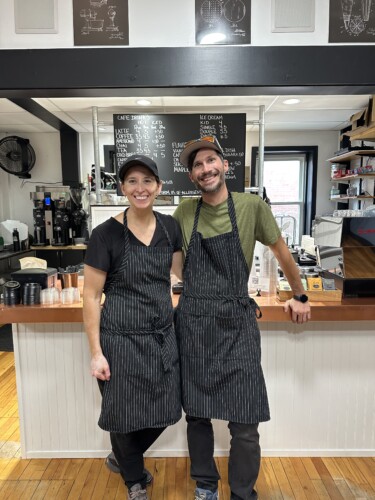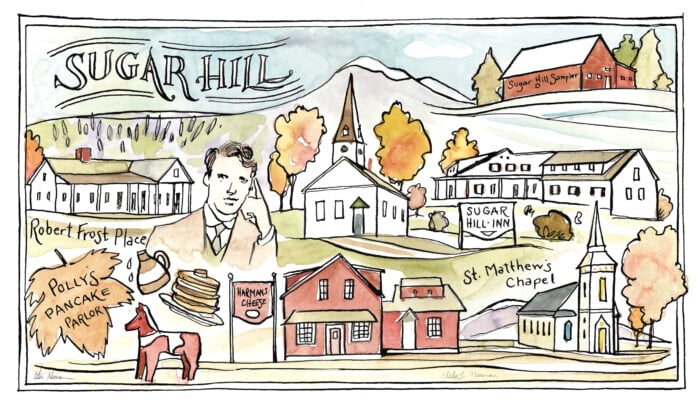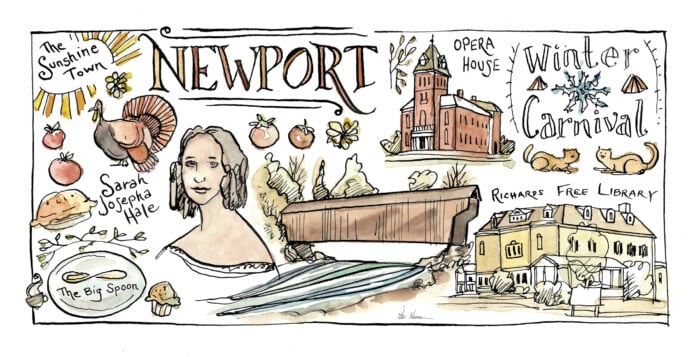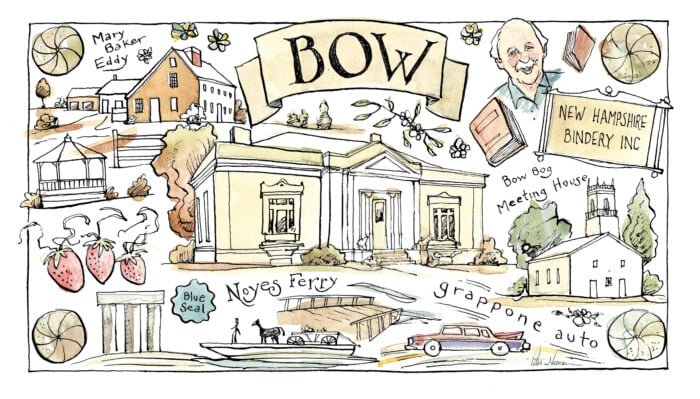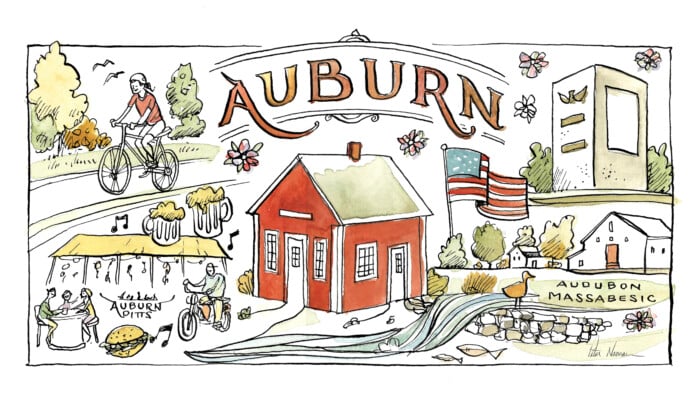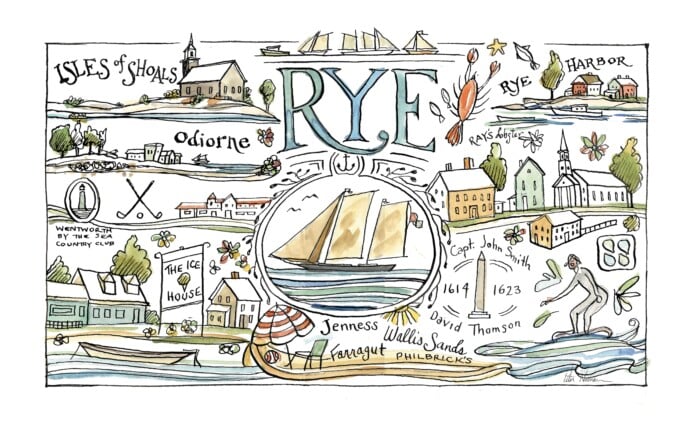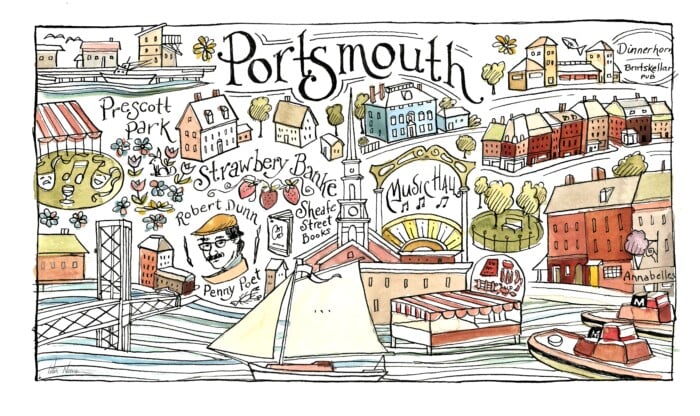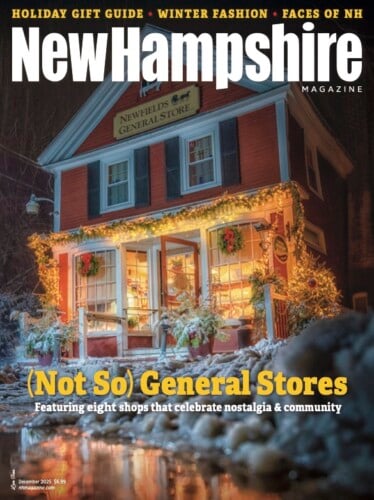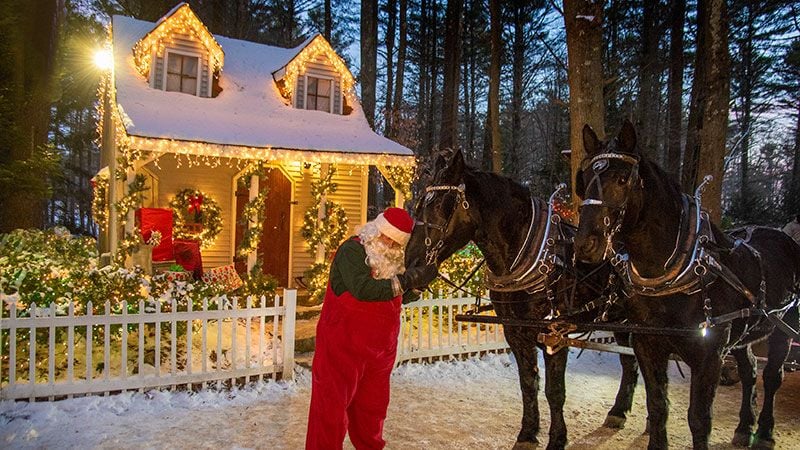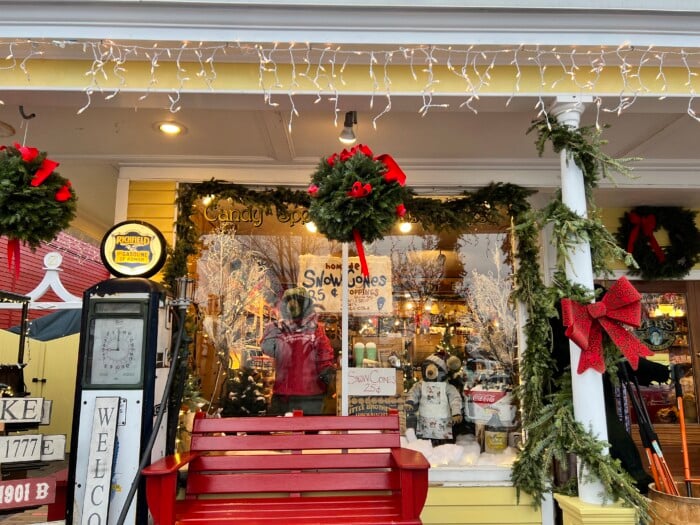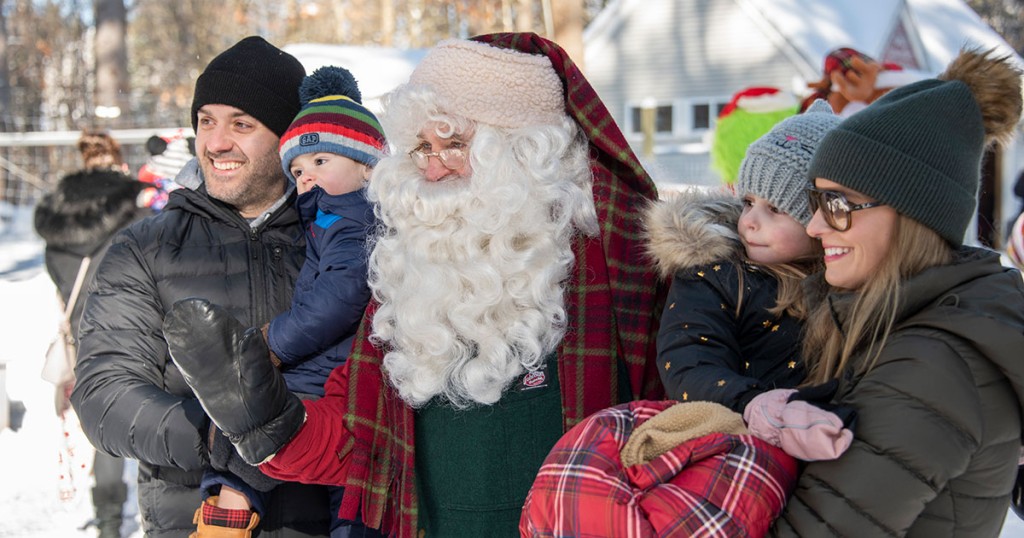Explore Newport, the Little Town that Could
Newport, NH is blending tradition and innovation to shape a vibrant future filled with murals, coffee shops and covered bridges
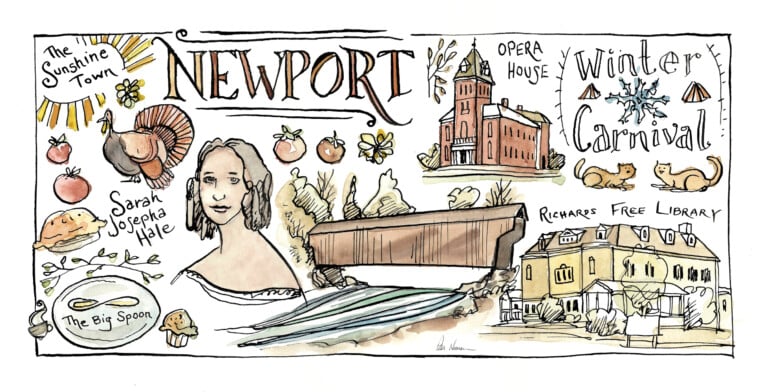
In 1993, the town of Newport had a decision to make. The Corbin Covered Bridge, a landmark built in 1845, was destroyed by a “suspicious fire.” There were two routes the town could take to get it rebuilt.
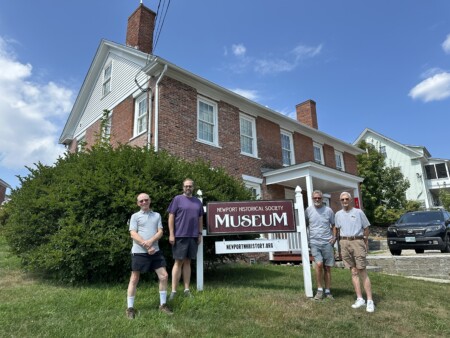
Current and former members of the Newport Historical Society board, from left: Dean Stetson, Tom Nulty, Mike Loftus and Larry Cote pose in front of the museum, which is open to visitors by appointment.
“Were they going to put a (new) covered bridge there or would they just have the state come in and put in a steel and concrete bridge?” says Kim Varney Chandler, author of “Covered Bridges of New Hampshire,” which features the Corbin bridge on its cover.
“The community said, ‘To heck with you, state, we’re going to do it our way,’ ” recalls Dean Stetson, president of the Newport Historical Society.
Chandler says they raised the money through a series of fundraisers. “They didn’t give up, and they fought for the bridge to be built.” Then, they got involved in literally rebuilding it: Chandler says people would stop by to offer to help Arnold Granton with the new structure.
It was a scrappy ambition, for town-wide projects seem to run through Newport’s population of approximately 6,400 people.
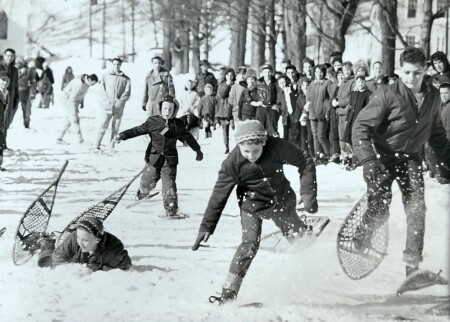
Newport’s Winter Carnival has always included moments of healthy competition, like this snowshoe race. Courtesy/ Newport Historical Society
“If I needed something, I could make one phone call and have 40 people at my door,” says Shannon MacMichael, executive director of the Newport Area Chamber of Commerce and nearly lifelong resident. “No questions asked, just ready and willing to help.”
Almost everyone who was interviewed for this story (unprompted) shared a similar sentiment; they’re also pretty much all Newport natives who moved away but were pulled back to the town.
“I’ve been privileged to experience what I call the Wizard of Oz syndrome. You grow up in a small community and you yearn for Oz … then you see Oz and you desire to come back to your little town in Kansas,” Stetson says.
To reach this magnetic community, hop on NH-Route 10 and drive far enough north or south until you suddenly find yourself on Newport’s Main Street, the Newport Opera House’s brick belfry presiding over the postcard-ready downtown. The Sullivan County seat is a small town with enough historical fun facts to fill a big city.
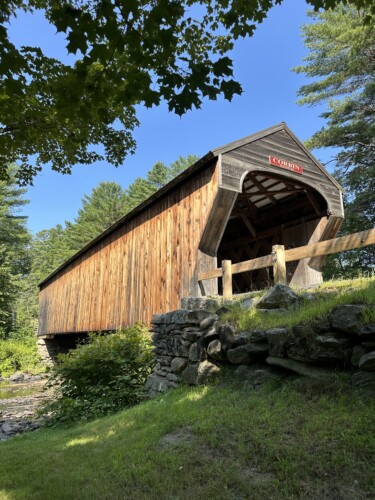
The Corbin Covered Bridge was rebuilt after the original structure was destroyed by a “suspicious fire” in 1993.
Newport was incorporated in 1766 by what Larry Cote, former director of the Newport Historical Museum, calls “an agricultural people.” Like so many towns in western New Hampshire, Newport quickly became a mill town, with the first factory built in 1768. Around that time, “we had a tremendous influx of immigrants coming to our community,” Stetson says. “They built our community.”
The textile mills were specifically seeking Finnish and Greek immigrants, Cote says: “(The mills) put out advertisements to get them to come to Newport. They were known to be hardworking people with skills.”
After the wool mills went south, the shoe shops came in.
“The quality of living went down a bit because the shoe shops didn’t pay what the wool mills did,” Cote says. In the 1970s and ’80s, the shoe factories left, and Newport became a service town.
Today, Newport is still largely a bedroom community (people live there but commute to work in other cities). LaValley Building Supply and Ruger Investment Castings offer the most employment opportunities in the town, according to MacMichael.
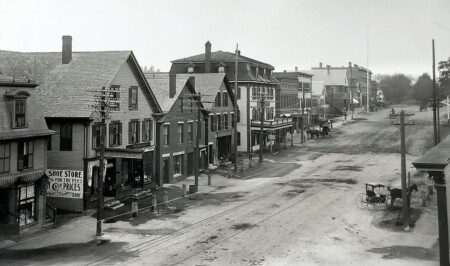
A photo of Newport’s Main Street, when horses could still be seen downtown. Courtesy/ Newport Historical Society
While the labor industries have shifted, the arts have remained a near-constant staple. When the Newport Town Hall and Courthouse was rebuilt in 1886 after being destroyed by fire, the new structure included the Newport Opera House. At the time, it was considered the largest stage north of Boston.
To walk into the still-used facility today is to jump back in time. The Opera House has 229 wooden seats, complete with wire structures underneath for men to hang their hats, lining the balcony.
The seats are quite comfortable, though the Newport Opera House Association’s executive director, Laura McCrillis Kessler, says they bought cushions a while ago. There’s no AC, so they don’t schedule performances during the summer. Sunlight shines through the original stained-glass windows, which were restored about five years ago.
The Newport Winter Carnival, another longtime staple, has been held every year since 1916, making it the oldest continuously celebrated winter carnival in the country. The Scandinavian immigrants who moved to the town for work had a heavy influence on the festival’s early itinerary, Stetson says. For instance, skijoring: a sport in which a person on skis is pulled by a dog or a horse.
MacMichael describes the carnival, which happens in February, as “five days of pure insanity.” PJ Lovely, recreation director for Newport, estimates that about 5,000 people attend, even though the changing climate has forced the town to tweak what’s on the schedule.
“A lot of winter activities have kind of slowed down, unfortunately, because the winters aren’t as hardy as they used to be,” Lovely says. Now, the agenda also includes non-weather-related events, like puzzle contests, trivia nights, a big parade and a scavenger hunt.
While there might be far fewer snow sculptures (and zero skijoring) these days, there are two things that haven’t wavered: ice skating on the common and the carnival queen pageant. “There are numerous photographs, postcards, and artworks depicting young and old skating on the common with the Baptist church in the background,” Stetson says of the former.
The carnival queen pageant is organized by the Newport Opera House Association.
“It’s a wonderful team building and bonding experience for these girls who come from different walks of life and have different interests,” says Kessler, noting that in 2024 the pageant awarded over $12,000 in scholarships. Stetson says many of the former queens have grown up to be quite prestigious: One who comes up often is the 1945 winner, Louise Crone. She eventually married Bing Russell and later gave birth to Kurt, who followed in his actor father’s footsteps.
Like so many rural towns, Newport has had its share of economic struggles, especially as manufacturing and younger generations moved elsewhere. Recent surveys put the median household income around $75,000, about 20% lower than the state-wide average.
“Newport, at first glance, can be seen as a town in struggle. In many ways, it is. If you look at our economics, it’s really stark,” says Kate Luppold, executive director of the Newport Library Arts Center. “But at the same time, there’s a lot of room for growth and opportunity.”
That growth and opportunity is the number one priority for MacMichael, who became the chamber of commerce’s executive director three years ago. “Growing up (in Newbury, NH), Newport kind of had this red ‘X’ on it,” MacMichael recalls. “It was this rundown mill town and had the typical negative connotations that go with that.” Now, she tells people, “This is actually the Hallmark movie town.”
Newport is only about 6 miles away from Mount Sunapee and less than 20 miles away from Mount Ascutney. Visitors to both see Newport as “more of a drive through town,” MacMichael says, but the chamber’s goal is to get them to stop and stay a while. The town is working with the newly developed regional tourism organization, Discover Sugar River Region, as well as doing their own promotion.
MacMichael has amped up the town’s digital presence: “We’re on TikTok, LinkedIn, Instagram and Facebook.” Older members of the chamber board “thought I was nuts for going on TikTok,” MacMichael said, but she knows the younger people she’s trying to reach aren’t exactly big Facebook users. She hopes to draw in younger generations who aren’t necessarily “popping in for a manufacturing job.”
The arts remain a central draw for the town. After a brief low period in the 1950s and ’60s, a group (spearheaded by Charles H. Massey and made up largely of volunteers) restored the Opera House to its early glory. Today, it hosts everything from community theater productions to nationwide names, like the Glenn Miller Orchestra, who will play there this November for the third year in a row.
The Library Arts Center, which was started in 1967 as a summer arts program, has developed into a year-round operation with multiple staff and plenty of art instructors running a variety of programs, all of which are free or low cost, across all age groups and many different artistic mediums.
“We’re a community art center, so we are very much rooted in the belief that art is for everyone,” Luppold says. In addition to displays of work from professional artists across New England, the center will simultaneously showcase work from hobby artists and children. The goal is to “showcase different talents in a very professional gallery setting that is able to draw people from around the state … but also help the participants feel appreciated … wherever they are in their own artistic process.”
The arts are also on full display in Korn Alley, a small, underused roadway off Main Street. As of 2025, it’s home to 21 murals created by 21 artists that depict “crowdsourced themes of what we love and appreciate about this region,” Luppold says. The project is a part of a five-year partnership the Library Arts Center has with the Newport Area Chamber of Commerce to bring sizable public art to downtown Newport.
Then, there’s the brand-new LaValley Community Center, which opened in March 2025. In addition to several multipurpose rooms that are being used for everything from pingpong to birthday parties to yoga and bootcamp classes, there’s a much bigger gym that holds about 500 spectators and can run two games at a time (say, an adult volleyball game on one side and youth basketball on the other).
“We’re athletic-oriented, but not strictly athletics,” Lovely says. “It’s adventure.” The center offers programs for people of all ages. On Friday nights, the gym is open for adults to come play old school PE games, like dodgeball, kickball and relay races. “We want to get people to come out and throw a dodge ball at their husband or wife, maybe have a beer after,” Lovely says. “Just kind of be social, but active.”
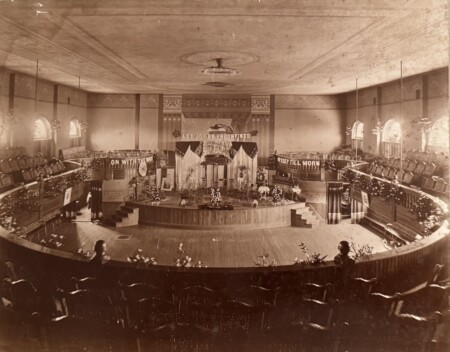
The Newport Opera House, shown here circa 1900, continues to host performances but closes in the summer due to a lack of air conditioning. Courtesy/ Newport Opera House
In general, MacMichael says, growing Main Street will be key to attracting visitors and long-term residents. One new business that’s already helping to bring new people in is The Big Spoon, a small batch bakery, coffee and ice cream shop that opened in July 2025.
Owners Michael Uhrin and Corey Lombardo are part of that younger generation MacMichael is trying to lure back. They both grew up in the Granite State (Salisbury and Loudon, respectively) and moved back once they decided to get married and have kids.
Lombardo is a professional chef, starting with a vocational program in high school and then attending the Culinary Institute of America in West Hyde Park, New York. She’s worked as a line cook and pastry chef across the country but was ready to give up the 16-hour days once their daughter, Olivia, was born.
Uhrin says Newport’s welcome has been warmer than they ever would have imagined. “Part of (opening new) restaurants are that there’s feedback, good and bad,” Uhrin says. “(With The Big Spoon) I wouldn’t be lying to say it’s like, 98% positive.” Lombardo agrees. “People come in and go, ‘Are you doing OK? You’re busy, right?’ ” she says. “They want us to be here.”
Uhrin is impressed with how engaged the community is.
“You go to an event and everybody’s there. And not just there,” he says. “They’re there and everyone’s having a good time and everyone’s really kind to each other.”
